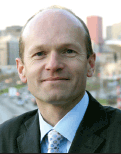- AI
- Molecular Imaging
- CT
- X-Ray
- Ultrasound
- MRI
- Facility Management
- Mammography
ECR's growth gives much needed boost for radiology
The European Congress of Radiology always falls at a special time of year. The bleak months of January and February are over, the plants are starting to reemerge in the garden, and spring and summer lie ahead.

The European Congress of Radiology always falls at a special time of year. The bleak months of January and February are over, the plants are starting to reemerge in the garden, and spring and summer lie ahead.
There was another reason why ECR came as a welcome relief to many people this year. After several months of bank collapses, redundancies, and other dismal economic news, it was uplifting to see that attendance at March's congress in Vienna held up remarkably well. The organizers reported a record number of delegates at 18,200.
Participation at the RSNA meeting three months earlier had fallen by 5% to 58,795. Although professional registration declined by only 1% to 27,586, attendance among exhibitors fell by a hefty 12% to 24,683. This led to heightened concern that ECR would also suffer from the downturn. But, thankfully, such fears were not realized.
It would be wrong to deduce from these statistics, however, that the European imaging community is in a buoyant mood. There are signs of unrest. In France, for example, the powerful FNMR (Fédération Nationale des Médecins Radiologues) has launched a vigorous campaign against the government's plans for substantial cuts to reimbursement levels for conventional x-ray, echocardiography, and ultrasound procedures. In a press release dated 12 March, FNMR president Dr. Jacques Niney referred to the deplorable measures by the Ministry of Health and the need to save French radiology.
In spite of its continued success-or in fact, precisely because of it-ECR faces challenges of its own.
Some of the lecture halls were full, particularly those staging the popular interactive education sessions (E3), and finding a suitable slot at the hands-on workshops proved to be no simple task. It is never easy for the organizers to anticipate which sessions are likely to be oversubscribed, but clearly the room scheduling for next year's congress needs to be examined closely. Furthermore, some delegates spoke about clashes in the program, notably in the cardiovascular field, and the slightly promotional nature of some presentations at the industry-sponsored symposia, the quality and objectivity of which are always hard to guarantee.
Other attendees had some trouble finding EPOS, the electronic poster area, in its new first-floor location, and they would have liked more space and monitors to view the exhibits. Also, parts of the technical exhibition appeared overcrowded during some breaks between sessions, making navigation difficult.
These are all relatively minor points, however, and most of them can be easily rectified over the coming months. Overall, ECR 2009 must go down as a resounding success, and we hope you enjoy our coverage of the congress in our May and June/July editions, as well as in our DiagnosticImaging.com webcast.
The Reading Room: Artificial Intelligence: What RSNA 2020 Offered, and What 2021 Could Bring
December 5th 2020Nina Kottler, M.D., chief medical officer of AI at Radiology Partners, discusses, during RSNA 2020, what new developments the annual meeting provided about these technologies, sessions to access, and what to expect in the coming year.
Current Perspectives on Radiology Workforce Issues and Potential Solutions
March 14th 2024Emphasizing the gravity of the ongoing workforce shortage in radiology, these authors recommend a change agenda focusing on expanded numbers of residency positions, reassessment of educational pathways, maintaining a strong presence in hospital settings and practice level initiatives to reduce administrative burden and achieve appropriate reimbursement beyond RVU measurements.
Could Cloud-Based 'Progressive Loading' be a Boon for Radiology Workflows?
March 13th 2024The newly launched Progressive Loading feature, available through RamSoft’s OmegaAI software, reportedly offers radiologist rapid uploading of images that is faster than on-site networks and other cloud-based systems regardless of the network radiologists are using.
